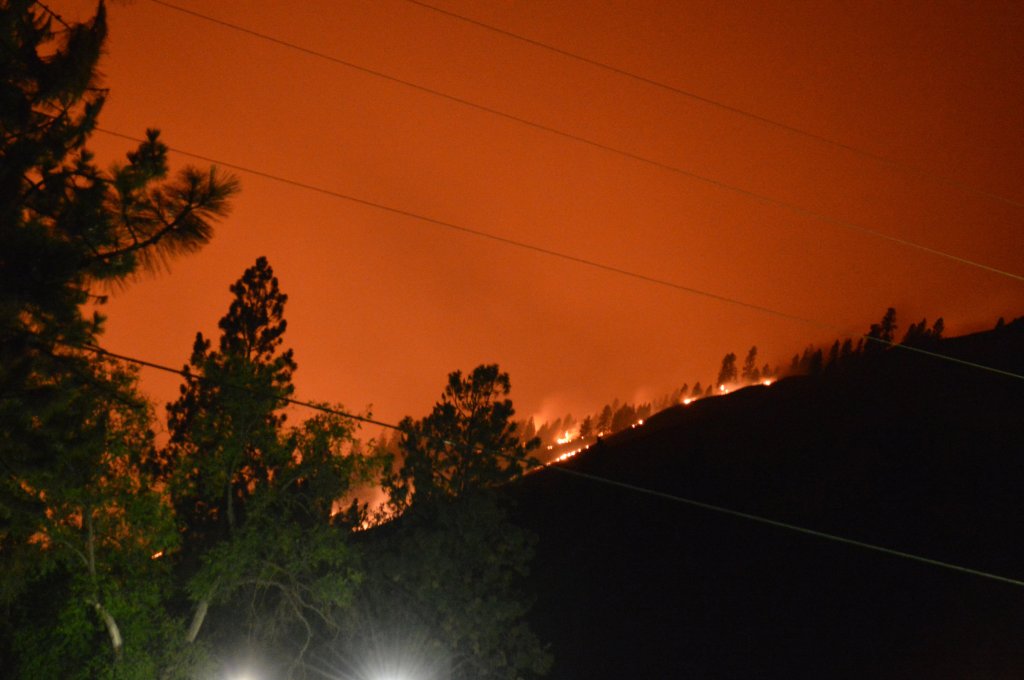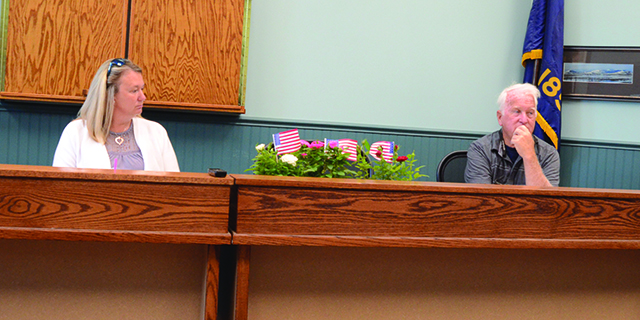Wildfire council releases report detailing $4 billion in investment
Published 2:00 pm Tuesday, November 19, 2019

- Steve Tool/ChieftainAbout 11 p.m.. the fire had crept down the Wenaha River to within .25 miles of the Shilo Inn Resort in Troy. By then the winds had died down considerably.
After revealing last month that it will take $4 billion to improve the state’s ability to respond to catastrophic wildfires, Gov. Kate Brown’s Council on Wildfire Response on Tuesday released recommendations on how the money should be spent.
The 110-page report said the state should focus on creating fire-adapted communities, restoring and maintaining resilient landscapes and effective wildfire response. In Wallowa County, residents of the Lostine River Canyon recently became certified as a Firewise community, one of the steps that is in tune with the report’s recommendations.
The report contains 37 prioritized specific recommendations with short-term, mid-range and long-term solutions. The report notes that to create fire-adapted communities, Oregon must leverage its land-use system to improve structural resiliency to wildfire, enhance defensible space surrounding structures, and ensure adequate access and egress in the event of wildfire events. Further, Oregon must ensure its electrical utilities implement best-practice risk mitigation strategies to reduce human-caused ignitions. Emergency response, disaster recovery and health systems must modernize to fully consider wildfire risks, particularly to Oregon’s most vulnerable communities and populations.
To restore and maintain resilient landscapes, the state must actively manage its forests and range lands, and prioritize treatments (thinning, prescribed burns, fuel removal) on 5.6 million acres of Oregon’s highest-risk natural systems. The costs of such treatments are significant, estimated at $4 billion over 20 years, but warranted given the far-greater costs of inaction. Studies suggest the comprehensive costs of wildfire (e.g., economic losses, lost taxes, damages to ecosystem services, destruction of infrastructure, depreciated property values, etc.) on average, are 11 times greater than the immediate costs of firefighting. With firefighting costs exceeding $500 million during high-fire seasons, comprehensive costs to Oregonians total several billion dollars – for a single year. Over a 20-year time span, comprehensive costs to Oregonians may easily total tens of billions of dollars. By investing in restoration treatments, Oregon may avoid these costs while creating green jobs in rural Oregon.
The council called for a new financing system to pay for wildfire suppression.
“These are big costs, and they’re obviously big investments, but the cost of inaction greatly exceeds the cost of action,” said Matt Donegan, council chair.
The council presented its broad plan to Brown last month, outlining a need over 20 years for $4 billion. At that time, Donegan explained that Oregon uses an antiquated model for fire suppression and mitigation which was created for a state with a third of its current population and even less resources.
Brown and Donegan point to one finding within the report they feel justifies the vast investment it’s going to take Oregon to modernize its wildfire response.
The report calculates that associated costs such as medical needs, loss of tourism and damage to infrastructure and watersheds are 11 times higher than the cost of wildfire suppression, and often take years to be fully recognized and paid. They include depreciated property values in areas where landscapes have been ravaged by fire, increased mental health, respiratory, and cardiovascular health issues in fire-effected communities, long-term natural resource losses, losses of tourism dollars, loss of tribal resources, invasive species management, and issues with water quality in streams, lakes, and reservoirs. The report notes that “…while federal and state agencies incur the majority of direct suppression costs, the bulk of long-term damage and human loss is borne by local communities where wildfire occurs. … Recent tragedies in California, including the historic Camp Fire and devastation to the small community of Paradise, demonstrate the difficulties in evacuating disabled and elderly citizens, and reuniting children with families.
In an interview Tuesday, Nov. 12, Donegan said the state spent $533 million on suppression in 2018, putting the associated costs at about $6 billion.
“Over 20 years we could easily be talking about tens of billions of dollars of damage,” Donegan said.
Brown said in a statement Nov. 12 that the report is a reminder that warming temperatures around the globe continue to increase the year-round risk of wildfire and the price tag that comes along with them. She said that if the state doesn’t act on climate change soon, Oregonians could see never-ending wildfire seasons.
“The devastation left in the wake of recent wildfires across the West is yet another alarming reminder of how this generation and the next will bear the costs of climate change — in lost dollars, homes, and lives,” Brown said. “If we do not act now, Oregon’s grandchildren will be left to pay an appalling price.”
“To actually have a proactive plan in place for our most vulnerable communities is important,” Donegan said.
Donegan said he has heard the call from Oregonians for a cohesive response, and now the council has provided lawmakers and state agency leaders the framework to act.
That framework includes among its highest priorities:
Developing and implementing an electrical transmission system wildfire plan. Utilities are obliged both by law and good business practice to protect their assets – and their customers – from the effects of wildfire. However, as recent and ongoing wildfires in California demonstrate, current standards for vegetation management, pole material, circuitry and monitoring systems are not designed to anticipate a wildfire. Oregon needs to develop its own standards, and implement them through the authority of the OPUC and other utility regulatory commissions.
Defensible space required around structures should be required according to the International Code Council Wildland Urban Interface Code (ICC WUI code), led by Office of State Fire Marshal allowing local enforcement and seamless integration outside ODF’s jurisdiction. A proposed state matching fund for low income residents is recommended for residents who could be dis-proportionally affected.
Revision of building codes to address specific requirements for wildfire-prone areas.
Other proposed measures include creating local, fire-focused economic opportunity funds, ensuring that fire insurance is available and affordable to property owners, and revising the current Stafford Disaster Recovery Act to make it more responsive to wildfire needs.
Brown’s natural resources policy advisor Jason Miner will join Donegan when he presents the council’s recommendations to lawmakers during legislative days at the Capitol next week.
The full report is downloadable at https://www.oregon.gov/gov/policy/Documents/FullWFCReport_2019.pdf
———









